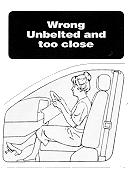 |
| Illustration
from National Highway Traffic Safety Admininstration
shows the wrong and right way to sit in a driver's
seat. Hints: Move seat rearward, buckle up, recline
back of seat and tilt wheel down. |
 |
Women & Children & Airbags
The Basic Facts and How to Stay
Safe
by
Cathy Nikkel
Airbags were installed in autos in the late 1980s to save lives
in crashes, and 7,000 hearts are statistically still
beating because of airbags. But this life-saving technology
has also killed 175 children and small-stature women.
How can this happen and what can an at-risk woman do
to protect herself?
Airbags
are designed to cushion occupants as the force of a
front-end crash pushes them forward. By providing a
cushion, an airbag keeps the occupant's head, neck and
chest from hitting the steering wheel or dashboard.
To perform well, an airbag must deploy quickly and forcefully.
The force is greatest in the first 2-3 inches after
the airbag bursts through its cover and begins to inflate.
The force decreases as the airbag inflates farther.
A
study published in the "American Journal of Public
Health" in October 2000 considered crash speeds
at which airbags are more likely to protect than to
harm. For men, the airbag becomes a protective device
in a crash of 8 mph or above, but for women the figure
was 32 mph. The study included 5,000 crashes between
1993 and 1996. The findings reflect the fact that all
initial testing for airbags was done with the 50-percentile
male crash-test dummy (the size of the average American
male). The government and manufacturers are now testing
with child-size and female-size test dummies.
Government
studies show that how close women sit to the airbag
is actually what puts them in jeopardy. Women who sit
very close to or on top of the airbag when it begins
to inflate can be hit with enough force to suffer serious
injury or death. However, occupants who are properly
restrained and sit 10 inches away from the airbag cover
will contact the airbag only after it has completely
or almost completely inflated. The airbag then will
cushion and protect them from hitting the hard surfaces
in the vehicle. (The 10-inch safety zone is measured
from the center of the breastbone to the cover of the
airbag.)
Progressive
Bags
Automakers
developed depowered airbags and began installing them
in 1998 to protect women and children from the bag's
force. Regulations now call for "smart" airbags
to be phased in by 2003, which can tailor deployment
based on crash severity, occupant size and position,
or seatbelt use. But the technology is proving elusive.
The General Accounting Office reports that automakers
are running into difficulties with the durability and
reliability of the devices. The sensors now being tested
have failed to show that they can operate reliably over
the 15-year life of a vehicle.
Since the risk zone for driver airbags is the first 2-3 inches of inflation, placing yourself 10 inches from your driver airbag provides you with a clear margin of safety. If you now sit less than 10 inches away, the National Highway Traffic Safety Administration offers several solutions:
-
Move your seat to the rear as far as you can while still reaching the pedals comfortably.
-
Slightly recline the back of the seat. Although vehicle designs vary, many drivers can achieve the 10-inch distance, even with the driver's seat all the way forward, simply by reclining the back of the seat somewhat.
-
If reclining the back of your seat makes it hard to see the road, raise yourself by using a firm, non-slippery cushion, or raise the seat if your vehicle has that feature.
-
If your steering wheel is adjustable, tilt it downward. This points the airbag toward your chest instead of your head and neck.
-
Certain risk groups can apply to the NHTSA for permission to install an on/off switch for the air bags in their vehicles. Forms are available at state motor-vehicle offices and may be available at automobile dealers and repair shops. You may also get one by calling the NHTSA Hotline or visiting its web site.
Smart Seatbelts
In some newer vehicles, seatbelts were specially designed to work together with airbags. If the crash forces become too great, these new seatbelts "give" or yield to avoid concentrating too much force on your chest. The airbag prevents you from moving too far forward after the seatbelts give. Without the airbag to cushion this forward movement, the chance of the occupant hitting the vehicle interior is increased.
Ask your vehicle manufacturer whether your seatbelts were specially designed to work with an airbag. If they were, your dealer or repair shop will provide you with information about the effects that turning off your airbag will have on the performance of the belts. Ask your dealer or repair shop to show you this information before you decide whether to have an on/off switch installed.
(article courtesy of Valvoline) |